A thorny problem

When is a thorn a thorn, and not a spine or a prickle? Generally, these terms are used casually and interchangeably. Botanically speaking, they are all ‘spinose structures’ that is hard, rigid extensions or modifications of leaves, roots, or stems - all of which have sharp, stiff ends. They all have the same role - to deter animals from eating the plant that bears them. Spinescent is a term that describes plants that bear sharp structures that deter herbivory. Thorns, spines and prickles are mechanical defences as opposed to chemical defences, such as tannins and phenolics, which create an unpleasant taste.
However, there are differences between these ‘structures’.
- thorns are derived from shoots (they may be branched or not, may or may not have leaves but they do have vascular tissue* within them). The thorns of Hawthorn (Crataegus monogyna) can bear leaves.
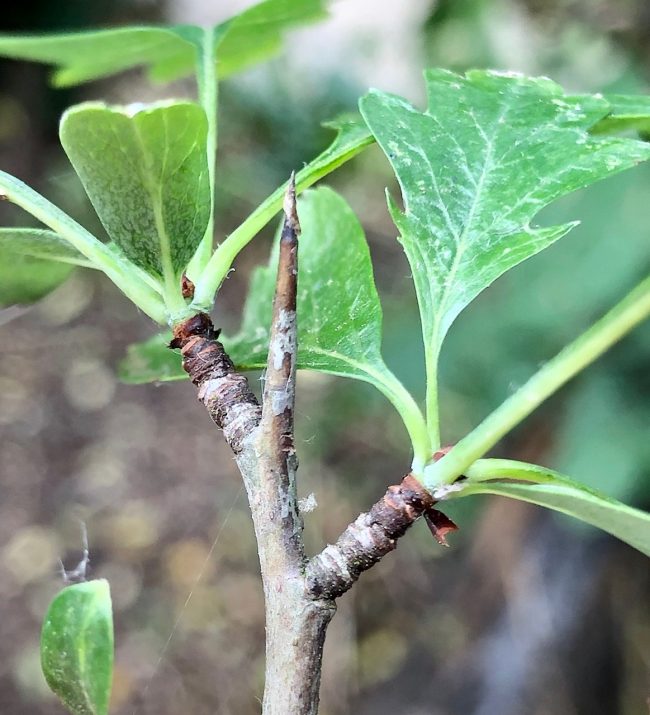
- spines are derived from leaves (formed from all of the leaf or some part of it and like thorns they have vascular tissue*)
- prickles are derived from the epidermis (the outer layer of cells of a stem, root or leaf). Prickles may be found almost anywhere on a plant and they do not have vascular tissue* inside.
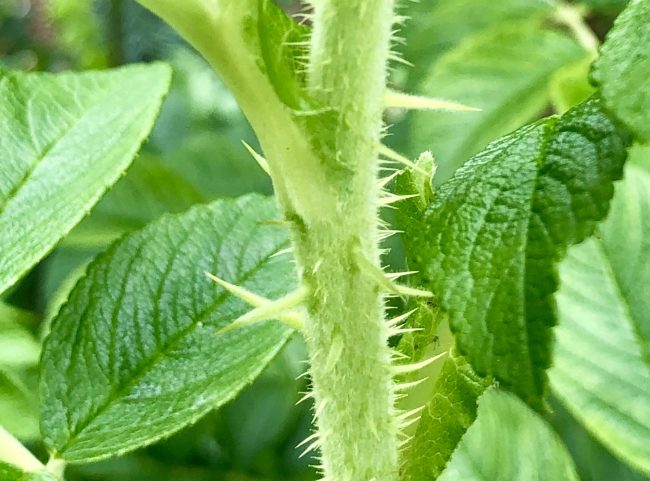
Prickles on a rose
[* Vascular tissue is the xylem and phloem. The xylem distributes water and minerals around the plant, whilst sugars move in the phloem]
The defences on roses are often described as thorns, but, in fact, they are prickles, as they do not have vascular tissue inside them. Young and old prickles can be broken off the stem relatively easily with the fingers (with due care), As the prickles age, lignin (the chemical that wood is made from) accumulates and the structure hardens.
Wild lemon and lime trees (members of the Genus Citrus) have spines, these protect young plants and indeed the fruits. Professor Vivian Irish (Yale University) has investigated the development of the spines in Citrus.
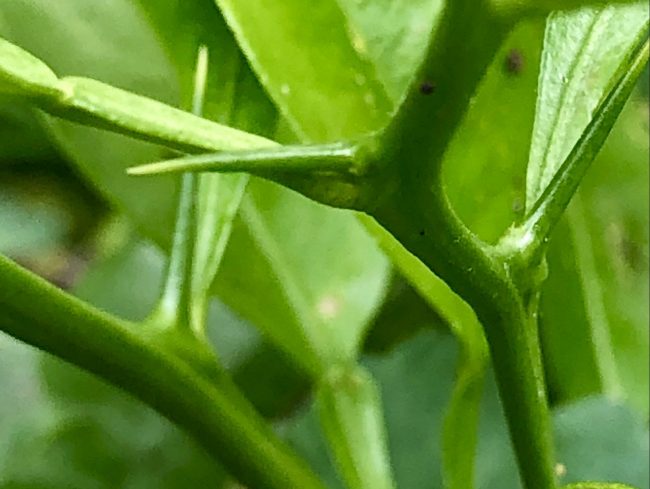
Spines on a lemon bush
The spines are formed from stem cells. Plant stem cells have distinctive properties,
- the ability to create specialised cell types and
- the ability to self-renew (meristematic)
However, the stem cells of thorn undergo a “programmed arrest” - they stop dividing. There are two gene regulators of stem cell activity, referred to as TI1 and TI2. They gradually switch off stem cell activity in the developing thorn, so that instead of becoming a shoot - it forms a thorn. Stem cell activity slows and then stops, resulting in the sharp pointed end of the thorn. The Yale research team found that if TI1 and TI2 were blocked or silenced, then new branches were formed but no new thorns.
Sometimes, the epidermis of a plant forms smaller. ‘simpler’ defences called trichomes. They are outgrowths of epidermal tissue but generally consist of only a few cells and may form a defence against small insects. Some plants have a leaf or stem epidermis that is covered with stiff trichomes, which may sting.
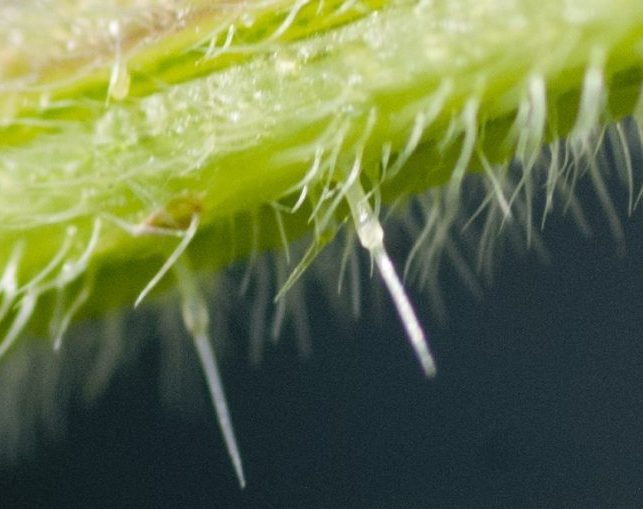
Trichomes of the stinging nettle
The classic example of this is the stinging nettle. The stinging nettle trichomes have a swollen base filled with a ‘cocktail of chemicals’, including histamine, serotonin, and formic acid. When the tip of a trichome is broken, it leaves a sharp point that can penetrate the skin thus delivering the ‘cocktail’ which results in the characteristic rash of a nettle sting.
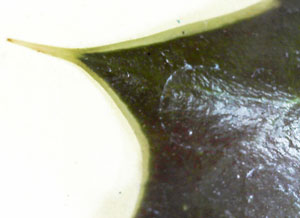 Other plant defensive structures include ‘teeth’ on the leaf margins and leaf apices. The classic example of such a leaf is those found on Holly. Prickly, spent leaves of holly would surely deter all but the most hungry of animals ? The leaves that develop at ground level are wavy, with large triangular ‘teeth’, bearing spines but as the tree grows (holly can reach up to 80 feet), the leaves become less spiny. Quoting from Trees and Shrubs Hardy in the British Isles by W Bean (a former Curator of the Royal Botanic Gardens at Kew), “The tops of good sized trees will be found almost wholly furnished with quite entire leaves”. Bean goes on to suggest, “The spines are a means of protection against grazing animals, and are no longer needed when the trees become tall.”
Other plant defensive structures include ‘teeth’ on the leaf margins and leaf apices. The classic example of such a leaf is those found on Holly. Prickly, spent leaves of holly would surely deter all but the most hungry of animals ? The leaves that develop at ground level are wavy, with large triangular ‘teeth’, bearing spines but as the tree grows (holly can reach up to 80 feet), the leaves become less spiny. Quoting from Trees and Shrubs Hardy in the British Isles by W Bean (a former Curator of the Royal Botanic Gardens at Kew), “The tops of good sized trees will be found almost wholly furnished with quite entire leaves”. Bean goes on to suggest, “The spines are a means of protection against grazing animals, and are no longer needed when the trees become tall.”
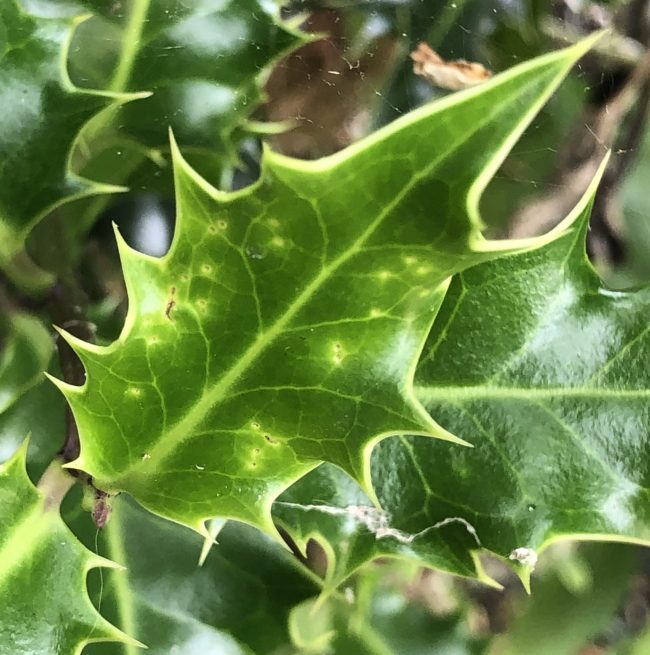
Spinose leaf of Holly
Comments are closed for this post.
Discussion
Agreed, a pyracantha crept in. Now a hawthorn.
Strange looking hawthorn… leaves all wrong at the base, twigs usually reddish..
also find this interesting. although only just begun woodland studies trying to keep up with granchildren who will one day inherit my woodlands and i hope continue my work of making uk more self reliant one its own wood instead of imports.thanks lewis
regards
roy.
sawmills.uk
Very informative and useful article for me. Thank you Lewis.

The changed image is much more representative of Hawthorn!
Mike Amphlett
6 July, 2020